February 25, 2010. Big Island, Hawaii
Phone
interview and questions by Bob Green
1. I’ve read that you made your first real
paipo in 1965 in Mr. Murakami’s shop class.
This is the first board that actually
looks like the boards that we
make now, with that delta shape, with the rails curved, with the nose
curved up and rails decaying slightly down. That was the first board
that I made like that. I made it out of plywood and koa wood, built up
the rails up with koa wood. Made a big square block of a thing out of
it and slowly carved the rails out with a chisel and hand grinders –
and made it the shape looking very similar to the boards we make now.
2. What were the earlier one’s like?
They were flat plywood, some of them
rectangular, some of them with
round noses, some of them were really long – over 4’ long, with big
nose, with smaller tails on them. All kinds of experimental things,
flat boards with wooden skegs and wooden handles on them. Painted with
house paint.
|
Paul holding an HPD
Photo courtesy of Paul Lindbergh
|
3.
Sounds like the old style ones I’ve seen photos of?
Exactly. Well you got to understand the
materials we had pre-1965 there wasn’t very much. They hadn’t invented
epoxy yet. At that age, we were like 15-16 years old, we didn’t have
much understanding either. People were out there trying to make
different wave riding machines. And for some reason you’d say, “Look at
this guy’s board he’s smoking”, so the next board I make will be more
like that or it will have a little of that. Or we’d change boards, “I
like that”, so the next board you make will have some of the
characteristics of that guy’s board. Like I said, the real paipo was
the manifestation of all the great designs, all in one. That board that
I made myself, was a board that I had seen, guys were riding this
board, a guy named John Waidelich. I believe he was the guy who
invented that shape and we were all guys trying to make boards similar
to that. I made my board, however it came out, it was like that. But
that’s a long bit of surfing.
Wood Paipos with Classic Lettering
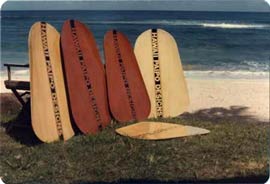 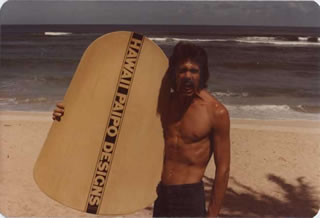
Photos courtesy of Paul Lindbergh, Hawaii Paipo Designs.
4.
Was Mr Murakami a surfer? Did he offer advice about making paipo boards?
No he wasn’t. He was a high school teacher.
What he was, he was a mentor, for young kids, young men like myself. He
said, “well, if you want to make this, this is probably how you could
possibly do it”. He let us think it out and he helped us. He wouldn’t
touch it, but he let us do it in his shop as a school project. That’s
what he did. He helped us by motivating us, letting us think these
things out and actually getting things done. We did some crazy stuff in
there. I built a boat in his shop. He was like “If you want to do
it, seek it out, show me the plans and he‘d give you guidance. He was a great guy.
5.
Sounds like he schooled a whole generation of surfers.
In his surf shop, I mean his wood shop at the
school I went to, guys would come in and make the old fashioned wooden
skegs. They’d make laminated skegs, hanging all over the ceiling. All
sorts of surf and water things. He was great. He let the boys go. But
he didn’t let them waste anything. “You have to give me a plan and then
you can go and do it. It was cool, he was.
7.
The prototype board, was it fiberglassed?
It didn’t start out to be fiberglassed.
Because, I made it out of a marine ply and Murakami recommended, he
said “Use boat glue in your laminations so that you don’t have a water
problem”. So I had koa wood for the rails. I don’t know what we did at
first, I think we just varnished it. Because they were strong all by
themselves and fiberglass was not something that everybody did,
yet. But it wasn’t long before you’d ding it a little bit, you’d
drag it across the rocks and then it got fiberglassed. It ultimately it
got fiberglassed. Ultimately over the years it got fiberglassed about 6
or 7 times. Every time I wanted to change the color of the
board, I’d just re-glass it. So the board right now it weighs about 30
pounds. It’s quite heavy but it still works. I still have it believe it
or not.
Examples of the older boards
Photo courtesy of Paul Lindbergh, Hawaii Paipo Designs.
8.
Were there commercial paipo being made at the time?
This guy Val Valentine, was making boards at
the time. I think he collaborated with this guy John Waidelich and Jim
Growney. These were older guys than me, I think they were like 10, 20
years older than me. They had really advanced everything. And Val
Valentine decided to try to mould one of their boards and made a not so
efficient press for it. He used thin sheets of plywood and tried to
press them. That was a board called as Paipo Nui. That’s what people
know as Paipo Nui and it was because of his commercialisation of that
shape that Paipo Nui got to be known. If you say “I got a Paipo Nui”
then you would know you were talking about this shape. Hawaiian’s know
this as Paipo Nui, only because Val made them. But he made some shitty
boards. He didn’t have his press really good and the problem with
pressing several pieces of plywood is that you can get a bend in the
nose, and you can get a bend of the side, but then you get a crinkle on
the corners. You press down the crinkle in the corner then you got two
crinkles in the corners. It’s very difficult to press that thing out.
The plywoods kina tough. Anyway he made some wonderful boards. I
remember when I was a kid I used to go to his house and beg him for old
seconds that didn’t work out. He’d sell them to us for like 15 bucks.
And the were all just really weird shapes, the thing warps back, it
wants to get its original shape back. And you know if it wasn’t for him
we wouldn’t have those boards. He made a lot of boards and people were
riding them all over the place. The only problem was that, it was made
out of plywood and he only varnished them. So the boards didn’t have
any longevity. You’d keep a board for a year before it fell apart. So
that’s why there’s so very few of those left around. Only people
who maybe who put them under the house. You’d be hard pressed to find
em, if you do they’re near flat by now. They have tried to get
their shape back. He was the guy.
9.
Where were people riding paipo at this stage?
At this stage people were riding paipo
everywhere. Every single spot that had surfboards out, lets say if you
are familiar with South Shore, Oahu, all the spots at Waikiki, all the
spots down like Ala Moana, all the spots around by Kewalo Basin.
Around the island, Makapu'u was exclusively a paipo place. People only
paipo’d or body-surfed there. North shore, every single place where
there was a pod of surfers sitting out you could see on the side a
small pod of paipo boarders. Every single spot, everybody just knew
they were there. Kinda like things that were always in the water. It
was different in those days it was different. Because nobody had
leashes, not on the big boards. Certainly not on the paipos. So there
weren’t the crowds we have today. Now you can buy a board, tie yourself
to it and see if you can hurt somebody.
Riding the North Shore on an HPD
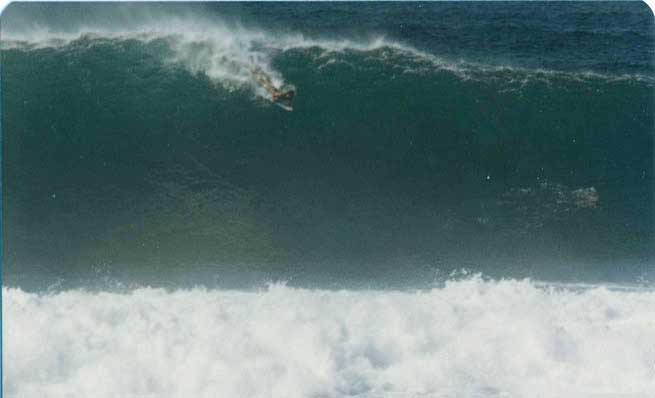
Photo courtesy of Paul Lindbergh, Hawaii Paipo Designs.
10.
Who were the guys you looked up to who rode paipos at that stage?
John Waidelich was the guy. Jim Growney.
They were the old guys, we were the kids. They were doing fantastic
stuff, riding big waves. There were zillions of kids doing insane
tricks on plywood boards. There were no names for those people. They
were just everybody. Any kid could stand up on a piece of plywood and
do spinners and stuff. They were just all over the place. When
you had a bunch of kids in the water on plywood they are always trying
to outdo each other. From moment to moment. We are talking years here.
It really developed quite nicely. That is kinda the shame of the
sponge. When the sponge came out all that went away. Trying to do
things ad get your board just right.
Also, another couple of guys who were really
good paipo riders, who were my contemporaries, one guy was named Andre
Vega. He was a high-school mate of mine who also rode Paipo Nui. He was
just a savage. He just loved big waves. He was very good. Another
guy was Rainer Stegemann. Another high-school guy. But he was like
exclusively a big wave guy. He still paipo’s now. He’s 60 something
years old and lives in California. Contact these guys and they
will tell you some stories.
11.
Did you make many boards commercially at the time or did you just make
them for your self/friends?
I just made them for myself. I tried to make
them commercially but I was only 16 years old. Everybody wanted this
board. If you go out and there is an obviously superior thing in the
water. Paipo boards we drooled over it. I tried to make it and I
couldn’t figure out how to bend the plywood to do that . Being only 16
years old. I tried to made a concrete mould. I went back to Murakami’s
shop and he said “ok, try”. We were pouring concrete up in his shop,
but the mould was too small, wasn’t big enough, that’s why I know about
these crinkles in the corners.
You learnt the hard way.
Yes. It didn’t work. Then we put too
much pressure on and the mould cracked. Then we had to dump that idea.
Then I made another board. It takes a long time to shape a board. Easy
a month to do that board. Shaping wood by hand, trying to be precise.
We used Val Valentine for a while. Val didn’t last that long. It
was if you wanted a Paipo Nui go get a board from Val. That was the
idea at the time but I was still trying, trying, trying to make a way
to do the plywood .
Val, for me anyway, as a kid, he was a bit
secretive, we couldn’t actually see how he made them. At that point I
was living right around the corner from him at Sunset Beach point.
You’d go past by house and his dog would bark, he wouldn’t like you
near his shop at all. That was fun for use kids anyway.
12.
You were 16 or so. I read on the web you described returning to the
North Shore in 1979 and not seeing paipo? Where had you been in the
meantime?
I was in the Army and I’d been in college, the
University of Hawaii.
13.
Were you doing much surfing at that time.
I was doing a little bit. I was working
hard at school. Trying to make money to go to school, to stay in
school. I didn’t have GI Bill and stuff.
14.
You mentioned boogie boards previously. Do you think people saw a
performance advantage in boogie boards or was there some other reason
they became so popular?
The reason I truly believe they became
popular, you have to go back and think about the time. It was truly, in
my opinion, the invention of this cross-link polyethyline foam, the
thing boogie boards are made of. The strong, soft
Ultra buoyant stuff. We had never seen
anything like that. It came out of the world of plastics. We had never
seen anything so cool, as something like that, that was rigid, yet it
wouldn’t hurt you. In the old days people were always really concerned
about being hit by a board, hit by a hard thing in a wave. Paipo
boarders never got hurt. I never saw a paipo boarder get hurt in my
life. But big board guys used to get hurt a lot. They had larger
boards, they were buoyant. If you hit the whitewater with that thing,
that board, it flips over and clunks you in the head. Everybody with a
big board got slammed somehow. The thing about surfing in those
days was that you got to be real careful. There was a careful thing.
They had thought about leashes on boards, but they thought, if you tie
your leg to this board it is going to hurt your leg, or it’s going to
pull the board back and it’s going to attack you. Safety in the water
was kinda a factor. It was so new. Rogues out there. Really and truly.
So it was that cross-link polyethyline foam. Basically we know they
just took a cookie cutter and cut out the sheets. It was so beautiful.
It was stunning. It was gold. Man, I thought, man, what a wonderful
thing. And they started selling that as boogie boards. Basically over
simplified, there was no performance at all. It was fun to take a
floaty thing out into the water. And it still is. People take inner
tubes out in the water. But in those days we didn’t have anything that
was like that, that floated so well, was so soft and was inexpensive.
It had a lot going for it.
That was the appeal right there. Nobody, you
couldn’t make that yourself. I know that Morey sold kits in
the early days to make your own boards, but
that was the materials you got. But that’s what it was. Very appealing,
we were like cavemen when that thing came out. You really got to put
your mind back in the day, imagine a day before that material actually
existed on the planet. Kinda hard.
Plastics themselves revolutionalised things,
didn’t they?
Yes, and this too. And not only that but you
know what it did, when it came out it was pretty inexpensive and it was
good to get started, kinda fun thing in the water. But what it did, it
took away from all those young kids I was telling you about that were
standing up on boards and building their own boards. Nobody built a
board ever again. The development of the paipo board stopped, dead,
right there. Because nobody was doing it. The lineage stopped. The
little kids were not looking, asking dad to help them find a piece of
plywood, to help them make that edge like this. Doing the projects,
like their homework. The lineage of this particular thing, it all
stopped.
So it had much broader ramifications? Like
relationships between fathers and sons.
Yes, a cultural rift took place with that
thing, right there. A creative thing. It is very deep, it runs very
deep. It is kinda strange effect. The sponge has a pretty low ceiling
in terms of performance. Even though guys put hard bottoms on them and
super drop rails or whatever they the hell they can do try to do to
save the design. You don’t see it out in big waves, like where paipo
boarders go. They have a ceiling, they’re not going to be out in big
waves. Even in small waves, you look at the old days of the kids on the
paipos. Anyway, it’s a thing under to itself. It’s a whole kinda
evolution, it made a whole lot of people happy, I gotta say that.
15.
Given all that context, what made you decide to give commercial paipo
manufacture a try when few people were riding paipo?
Well, they weren’t riding paipos because there
weren’t any paipos to ride. Ok, that’s what my vision was – if there
were no paipos to ride where are you going to get one? Val had
been dead for years and years. I was the only one, as far as I could
tell and I was kind of a mechanical maniac you now, so I was
talking to a lifeguard at the time, Sean Ross, and he laughed at me,
and he said “no more paipos Paul, boogie boards, look”. The early
boogie boards weren’t very good. Man, I went home and said,
“this is a shame” because I felt if I didn’t try now , there would be
no paipo boards ever again. I really felt like that as a young man. I
went home and laying out plans, blueprints. I made a massive concrete
mould. It was big. It had bolts all around it to torque down. Then the
big old drawings and I poured the bottom of it. I bought a concrete
mixer into my flat, or flat under a house. And we snuck it in, in the
middle of the night. I made the form with all the glee (?) bar in it
and all of the fittings and everything, you know. We cranked it up and
the landlord wasn’t there. We had this thing probably close to a ton on
the floor I the apartment.
Paipo
rider Sean Ross having fun at the Pipeline on an HPD. Sean was a life
guard at the Ehukai Beach (Pipeline) for years in the 1970's.
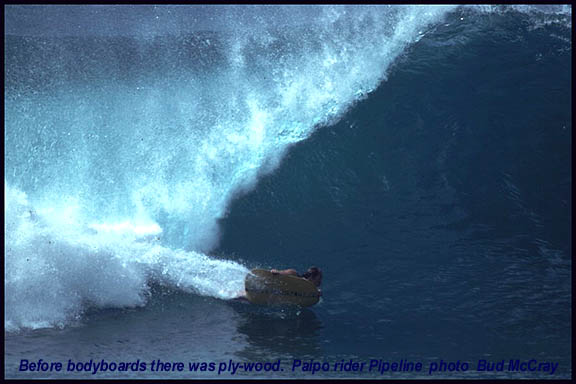
Photo: Alan McCray, Hawaii.
He never got wise to that. Then I moved a
couple of months after that and I managed to truck that thing out of
there. Then I built the top half for it. It was a long, long process
but I had to make it massive. That was when I started to making them
out of plywood. Putting three thin sheets of mahogany plywood in there
and some boat glue. And just crushing it. Crush, crush, crush.
And then taking it out and I have a blank. I had to shape that. The
thing about shaping this thing, was, really inane, to make the rail
perfectly straight and to make the nose perfectly level and
perfectly semi-circular and have the other side go back down and decay
to form a straight line to the tail again, that was insane. Because you
had to cut the rail after it came out of the press. You couldn’t just
draw a line because one side would decay faster than the other side if
you didn’t have it just perfectly, so it was a matter of standing there
with a level, and drawing the level back, back, back to making sure
both sides were level and eyeballing it to make sure that it is
perfectly straight. It was really insane. But that was the first thing
I did. I said “we are getting close here”. It looked beautiful, you
know. All the wooden boards on the web-site, they were red and all
coloured. I used to paint them or stain them and had some airbrushed.
After that I that I had very thin fiberglass.
16.
You mentioned previously finding that balance between lightness and
strength? Was that difficult?
At the time, lightness was a thing. The
strength was inherent in the ply. There is nothing stronger than the
ply in those old boards made out of plywood. Because you put the
plywood in and the plywood in itself, in one piece of plywood the grain
goes north and south, the middle layer goes east and west and the final
layer goes north and south again. So I take three of those, and
then stagger them side to side and you have an insane amount of fibre
integrity in there. The only reason I fiberglassed them was to keep the
water away from the wood, that’s all. But they were super boards. I
made those boards every day. I was making boards, boards. People were
coming from all over the place. They were coming from the mainland to
buy them. I was selling them cheap because I had a job. I didn’t really
the need the money and I felt that I was in a process of developing
this paipo, of getting paipos back out. But it was really a pain in the
arse. It was really very difficult.
When you say cheap, how much were they going
for?
In those days I think they were going for
about for $100.
17.
You’ve mentioned the big mold, does the construction process differ
much now?
Oh yeah, the construction is way different.
What I have, the board is made out of fiberglass and foam, for one
thing.
I get my fibre strength from the fiberglass
and also it’s a kinda a semi-vacuum bag. It’s kinda a strange process.
It does use vacuum. The problem with all the old wooden boards, there
were two problems. The wood has natural oil in it. Even though the wood
seems dry, just powdery dry, there is oil in there. Even though it does
look like the fiberglass is staying on there nicely. In about a year it
starts not liking that. The fiberglass doesn’t like to lay on oil, the
other problem is inherent in the wood grain there is air, so it didn’t
like being sealed in under the fiberglass because if you take that out
into the sun the little airs tend to expand and contract. You put it
out in the water, leave it in the sun, you get little bubbles under it.
Over a period of time that’s not acceptable. So that’s why I had to go
to the vacuum system where I get completely all the air out of the
product.
So there’s no molds any more?
Oh well, there’s no big concrete molds any
more, no. What happened when I left my house in Haleiwa they tore down
the house and took the mould.
With your new boards is there any moulding at
all or is it shaped piece of foam?
There’s kinda a mould. There’s profiles I put
on as well, when it is wet and vacuum that. It’s kinda strange
process. I have been developing that process for the last 15,20
years now. I’ve got it down, where I can get a really, really
strong product with reasonably little distress to myself. I’ve made
thousands of these things and I’m the only one. People are starting to
make paipo boards now, they are making all different kinds. They are
all kind of retro boards, boards that we used to have early on.
They are very pretty. Wood boards, laminated boards, all the shapes
that we used to have. But I am the only one who is doing this
particular type of board. I still feel a little bit of responsibility
to this whole paipo thing. I just loved it, you know. The board is
great. It still looks great. There is still nothing that you can ride
that’s faster or more fun to be in the water with or less hassle to be
in the water. The big floaty things are a drag.
18.
I was going to ask you about your new model with the flex in the tail.
What is the theory about the flex in the tail and what has been the
response of people who have ridden the new board?
I’ve only made a few of those. But basically,
what it is. Sean Ross, was a guy who was my experimental rider for so
long. I made boards for him his whole life. He was a lifeguard at
Ehukai, basically at Pipeline, North Shore. He liked to have that
board, when he made a bottom turn on a big wave, he liked that board to
bend a little bit, you know. So well ok, so we thinned out the board
but the idea is if you if you can’t thin out the board you have to keep
the rails really strong so that they’ll support you. He wanted that
thing to just have a little bend in it so when you came out of a turn
it kinda flexed back, like a bow and arrow shot. A little extra kick.
So I was designed a board for him and we’ll call it the SR model where
I took out all the foam out of the center of the board, so that the
board would bend in the center. But what I did, was left the tail
aspect, I left about 6’’ of foam in there across it – like a little
beam across the back. I left it that there because I was concerned that
I needed to make the rails as thick as I could just because I didn’t
want anybody to get hit with it. If you made it thinner than what we
got now, it’s a ½” now, made it thinner than that it could possibly be
a problem to the general public. That’s what I was thinking early on.
Flex Model, the Paipo SR
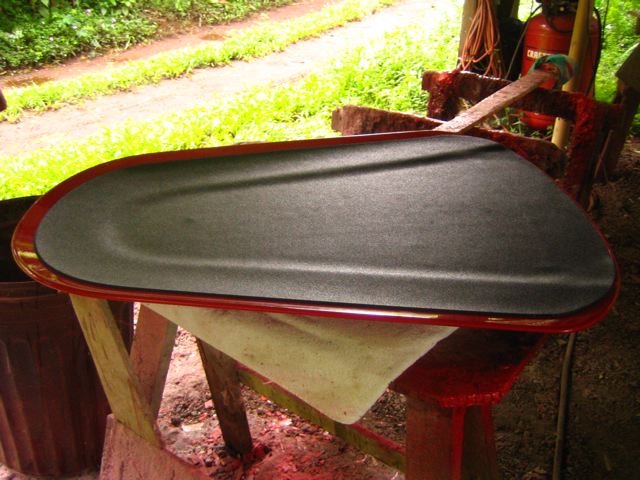
Photo courtesy of Paul Lindbergh, Hawaii Paipo Designs.
And then I made a spoon, you know a George
Greenough spoon, the whole mentality about the spoon. You look on the
web and you will see people making spoons. This guy challenged me to
make a spoon. So I thought, “Oh boy”. I made a whole set of profiles
and molds and stuff, I wasn’t going to just make one, I was going to
be prepared to make 20. I had all that, I did all that. The spoon is
kinda really cool. I personally liked the stiff board, I don’t have a
feel for the spoon. I don’t particularly like it, but people do. They
become a little fanatic about that. Then what happened was, this guy
who buys a lot of boards from us, he said what about, we could make
that board a little better. What I did was on a regular paipo, I
took out that tail, that little beam, that goes from east to west in
the back and made it completely thin throughout the middle all the way
to the tail. I can stick my knee in it and it is really flexible and
really strong. It like wangs back. It’s not loose or flappy in any way.
It’s very tightly wound. But it does bend nicely. That thick tail
prevented the whole board from bending correctly in my effort to
protect the general public from themselves. It really screwed up the
design I was trying to get to. So I basically we have a paipo
board designed like the spoon internally but it does have that that
flexibility in the bottom. I made a couple more and I gave them to guys
to go and ride. A guy wrote back from California who he is totally nuts
about it, he can’t believe
it, “this is it, Paul this is the board, I’ve
been waiting for.” There’s two boards I gave to local guys who are not
reporting back.
19.
What makes a paipo go fast in your view?
I don’t really know how to explain it in
technically, in a scientific manner, but the way I view it. Have you
heard of the Venturi effect? Working on a flat surface, the nose of the
board is small and the back of the board is wide. So you have X amount
of wave coming under the board, a small amount of water coming
under the nose and then it hits a wider surface. What you do is you get
lift from that, you get aqua lift from the back of the board. The board
actually wants to ram forward, once the water is coming in under the
board. That’s what basically makes it really rocket. If you were
to take your feet out of the water and just kinda be a ball of wake on
it, the board would spin around backwards. Because the back wants to
get ahead of the front. It will spin around. If you are riding on it,
laying on it properly, it accelerates like crazy, on it’s own. The back
wants to get ahead of the front. That’s an over simplification.
The other thing is this, basically the board
is working on surface tension. The actual top layer of the water is
different to under water. You see these guys riding the sand-slide
boards. Basically paipo boards work the same way as they do, in that it
adheres to the surface of the water. The only time it penetrates is
when you turn and you cut your rail into it and your rail just becomes
a skeg. And then if you need flat-out speed you are basically riding a
sand-slide board. It is only the surface tension of the water, you are
not digging in, there’s no skeg to hold you back
and it’s stiff enough to not give you any
chatter on a wave. You can’t skim board with a boogie board, can you?
You just penetrate into the water, even though
the thing is buoyant. Our boards work have always on the surface
tension. It’s not something we invented or anything. It’s just kinda
one of these things, we are just on the end of a long lineage here.
Guys ask me that and I try to explain it. I never did try to explain
when I was a little kid, I just wanted to get on it and go like hell.
I guess as we get older we think more about
these things.
Well I’ve been carrying this torch as it were
for my whole life and people been asking me these things for so long.
And now, so many generations of people that don’t know about paipo
boards ask me questions and they have been riding sponges their whole
life and think that the only thing there is and ever was, you know. So
I have kinda been pressed trying to figure out what to tell them.
You do get asked some odd questions.
I appreciate the curiosity. I don’t think
anybody that I ever got a board has been disappointed. They have to be
curious in the first place to track us down.
20.
What are your thoughts about fins on a paipo?
Our shape paipo, you can’t really put a skeg
on it. There is that thing about violating the surface tension by
jamming something in the water. Basically, you need a skeg just like
how a kite needs a tail. That’s all it’s really for on a paipo I mean.
Here’s the problem with our boards. We put skegs all over them. We’ve
been doing this since we were kids. “Of course it needs a skeg, where
are we going to put it?” I’ve got boards with eight skegs on it. We
built the boards so we can do what we like. You know the board is
kinda a delta shape. So where are you going to put the skeg, are you
going to put it in line with the rail or are you going to put it dead
down the center, straight down the center? If you put it on the
rail with the straight edge of the rail, which is the point you stick
in the water then you are going to have the opposing skeg, it’s going
to be like a snow plough, they’ll be toed in so as to speak. They’ll be
following that delta. If you are going straight it is a ridiculous
amount of drag. If they both follow each rail, one on each side they
will be toed in too much and you won’t be able to go straight. The
other thinking is this if you put one straight down the center,
following the center line, then when you are on your rail, riding on
your rail, then these skegs are askew again and will give you a whole
bunch of drag. They’re not necessary. You know these boards
steer really strangely because the back of the board wants to kick up
and like I said get ahead of the front. There is a way which I like to
do, you can ride it like a boogie board ride and steer with the nose
but you can you can also steer with the stern of the board. You can let
the back of the board slide around and then dig it in. It’s almost
like, I tell some guys, it’s like kinda driving a forklift sometimes,
where the steering is in the back.
21.
You’ve mentioned you sell a quite a lot of boards, where is the market
for paipo? Is it largely in Hawaii or elsewhere?
All over the mainland, of course the west
coast United States for one thing. And believe it or not a large market
on the east coast, up north even in Nova Scotia. Apparently there’s
wonderful waves up there. That whole east coast north to south, from
Florida to Nova Scotia, which is in Canada. Sold lots and lots of
boards to those guys. I say “how can you do it, it’s so cold up there”?
They say the waves are just to beautiful. In the wintertime they get
these nor'easter coming in there and they get these huge big glassy
swells. They put on their wetsuits and just go out. They just love it.
That’s our main market for boards.
The problem with selling boards, people in
Japan like em. The Aussies love them, New Zealand people. We sold bo
ards to people in the UK and France. All over the world. The only thing
that really restricts those markets is the cost of shipping and the
stupid duties and taxes that they’ll have. That’s the only thing
that inhibits that market. But everybody wants them.
The shipping costs about as much as the board
does.
Yeah, for international it does, that’s
exactly what it costs. If you spend 300 on a board it’s going to cost
you about 300 to get it to Australia or Japan or UK or wherever. They
have got us handcuffed there. They’re not liking to help people sell
things all over the world. Everybody can get to your web-site and they
go “Oh man”. I have so many different ways of getting boards out of the
country. “My uncle is coming through give him three boards” …
“He’s going to be in LA, ship it to this address and somebody will pick
it up”. I’m going “oh God”. We’re willing to bend over backwards to try
to get boards to people, especially people who love to surf and I
think, especially people in Australia, people have just such a love for
surfing as we do in Hawaii. If we got something that they can use I’ll
break my back to try to get one to them, as best I can.
22.
Speaking of people who ride your boards who are some of the people who
have ridden your boards well or ripped on them?
I really don’t know. This is only local guys
and nobody knows who they are. We’ve sold thousands of boards out there
to people who keep writing back, claiming they are gods gift to surf.
Me, I stay home, I got my own little spot here and stay in my shop.
Sean, all the lifeguards on the North Shore.
Buffalo Keaulana, how about that. Buffalo’s got one of my boards and he
just loves it.
He’s a legend.
He’s a legend, right. A legend on the board. I
got him a board one time and boy, his face just lit up like he’s a kid.
He knew about the board long time ago. You know what happened?
When Sean Ross was a little kid, not a little kid, but he was a young
man starting out in the lifeguard business he was stationed out at
Buffalos place at Makaha Beach. Apparently he had that board and Buffalo was
really intrigued by that board. It wasn’t until maybe 5,6 years ago
that I bumped into him and we were talking about the board and he was
getting all dreamy eyed. I turned him onto one, he went “aargh” and
almost had a heart attack. He loved that.
I don’t know, for me it’s not an individual
thing any more. It’s like getting them to people, a lot of people want
em. It’s just taking too much effort for me to get all the boards out
much less keep track of everybody. There’s a whole new generation now,
people that are riding paipo boards now. I don’t even know who’s
who in the surf world any more. I’m kinda getting old and I’m just
trying to complete this project so to speak.
23.
Is it a one-man operation?
Sometimes I am, sometimes when there’s a lot
of boards to be made I get some local guys to help me. Generally
speaking it’s just me. There’s a crew who helps me in the shop, helps
me cut materials and do a lot prep work. Sometimes I got a lot of
boards to make.
24.
What is the attraction of paipo boards?
The color. Wanna go fast. People want to go
fast, people want to fly. Your’re looking at the Olympics. All people
want to do is fly, they want to fly. And they look at that board and
they say “that sucker flies”. The main attraction in reality, not only
the speed and maneuverability but something that people haven’t quite
unlearned yet about buoyancy. There’s no need for buoyancy on a
thing that planes on the surface. Big waves come,you take your paipo
and you dive. You can dive all the way to the bottom. Being out in big
waves is no fun if you got a big floaty thing. I have been out at
Sunset Beach, 20’ and “Oh my god you know, outside sets coming”,
outside set you can’t make it, that’s all. You can start swimming but
you’re not going to make it. You can start paddling. You can
paddle a paipo board as fast as a guy can paddle a surfboard. I mean
for a sprint not a problem. For us, outside, just be real cool, head
south, stick your board in the water and swim down to the bottom.
And you come back up and you are outside, you didn’t even get pushed in
at all. There is usually another wave you gotta do it twice. I was
talking to this guy the other day and he was telling me about the sound
on the bottom out at Sunset. This tinkling, tinkling, tinkling sound of
the coral down there. It sounds like a gigantic glass chandelier. When
you get down there everything goes black, but you are down on the
bottom. You’re not getting pounded by 15’ wave. You keep swimming and
you come up and you are outside all by yourself, you turn around and
you take-off. Everybody else is clinging to their big guns and in the
situation like that there’s no boogie boards at all. For regular
surfboards there can be a problem because of the flotation thing.
There’s no need for it. I was talking to a guy the other day and I was
saying, you now, there’s something about man and being a
cro-magnon cave dweller who if he is out in the water, away from land
he needs to have a floaty thing with him. “Good boat, floats
good. I am safe. I have a floaty with me”. It’s just kinda a
mindset that you need to have something floaty out there. I tell guys
it’s like being out in a rough surf with one of those life jackets from
the Titanic on, you are going to get killed. Kick it off.
One of the unwritten realms is I enjoy going
under waves. You can really bury them. It’s great fun just planing
underwater as waves go over the top you.
Oh absolutely, all those dynamics which you
are talking about are in place. You know, one of the funniest things
that I get reports from the guys is that they are dubious about the
flotation thing. I am going, “I can’t sit here and sell you the board
man, I am busy”. They write back, “you know, with your board I
can stay out in the water twice as long, I can stay out in the water
all day, I don’t get tired riding a paipo board, I’m not fighting with
the surf”. You take the fight out of the whole thing and it’s more fun.
Like you say, you can do a lot with that. The dynamic that planes a
board across the wave also you can go underwater with it, same thing.
We didn’t invent it, it’s just kinda a natural dynamic that exists in
nature. Real quickly, I’ll tell you something that I mention sometimes,
if you take a paipo board and let’s say you go in a swimming pool and
you are standing on a diving board as an experiment. Let’s say you drop
that board and it is perfectly horizontal and it hits the water, it
will stop right there. And, lets just say you wanted to have a more of
an experiment, well you jumped off with it, and you are holding that
board perpendicular to the water, parallel to the water and it hits
that the water. And you hit that board you would probably die because
the board stops when you hit the water. Now, if you turn the board the
other way, nose down and just drop it, you will probably go all the way
to the bottom of the pool. You can do the same thing, if you want to go
with it, stay right on it and you can jump off the diving board and you
can dive right to the bottom with the board and it will come up to.
Follow it as it starts arcing up. There are a lot of severe dynamics in
place that make that thing work really good and makes it a whole lot of
fun.
It’s a different realm.
It’s a whole different thing. It’s just
something people have to discover or re-discover. Boogie boards came
with this beautiful material and very smart marketing they saturated
the planet with it. Like it did bring a lot of joy to a lot people who
are not necessarily surfers.
25.
Do you get to surf much these days? How old
are you now?
Not too much, I don’t surf too much. I body
surf, I fish. I’m kinda old now. I’m 60.
26.
Over the years are there any surfs or waves that still stand out for
you?
Many, many days out at Sunset Beach when I
lived there. After school surfing, going there, in the days before they
developed the beach, the days before they had lifeguard stands, the
days before they the road was improved. I’d surf out there everyday
after school. I remember being out there in about 8-10’ surf just me
and my older brother, he’d ride his gun and I’d ride my paipo. We’d go
right down the beach and jump in, glassy waves, nobody else out. That
was heaven, days like that were just incredible. Wonderful surfing you
know.
That would be a rare privilege.
Absolutely, absolutely. That is what I am
saying. You asked, I didn’t say that it but it came to my mind
There was one especially giant day at Makapu'u.
I forget when it was. It was in the early 60s when the whole east side
of the island went berserk. That was a famous day, a famous week
actually. A lot of people will remember that. Rainer will remember that
more accurately than me. That was a monster day, 20’ day out at
Makapu'u, a place that doesn’t handle that kind of surf. We were the
only two guys out. It was pretty awesome, we did that. It was just
monstrous, The current was insane and the waves were just monstrous.
There were two skinny guys out there on paipo boards. Caught a couple
and made it in through the shorebreak and everything .It was just
fabulous. That was a moment to remember.
But I was saying, was that for that all North
Shore that was gorgeous surf, that took me for years and years. Cath
was saying “don’t I miss it” and I said “I don’t miss it. I was there
and I did it.” What existed then does not exist now. You can’t go out
at Sunset on a beautiful day, it doesn’t exist. I’m good.
You wouldn’t even get waves these days.
We used to surf by ourselves, me and my
brother. Just two guys, out at Sunset Beach on choice glassy 8-10 days.
Just nobody out. The North Shore was not that populated in those days.
A fairly remote place. It took a long time to get there from Honolulu.
They didn’t even have the cross the island freeway yet. That was the
spot, it was really remote out there. We didn’t think of it anything at
the time. We didn’t think what would happen. Pretty soon there lots of
people. Anyway it ended up like that. Like I said I don’t miss surfing
anymore because I was there, I did it. There is nothing to miss. I
didn’t miss it.
27. What
do you see as the future for the manufacture and surfing of paipo
boards,?
Well, I think that is fabulous, the potential
is incredibly good. I don’t do anything. I have a web-site that I
don’t even attend to. It’s my life’s business. If somebody was to
advertise a little bit, or market a little bit then it would just
become another big business, that’s all, it would be like snowboards.
What’s happened with snowboards, things of that nature. I just don’t
have the desire to market. I am going just as hard as I can making
boards for people that root me out. I think if somebody else wants to
go the hole hog and market it, then they would make an awful lot of
money. That’s what I am saying.
What about the actual surfing of paipos. Do
you think that will ever take off? What direction do you think it might
head in?
I don’t really know. I think anybody that puts
a paipo board under them and is to understand that this is now not an
old beat up Volkswagen that it’s a Ferrari. It takes you a minute to
figure out how to drive it, but once you are on it, it’s all
self-explanatory. You are now a paipo rider. There’s no more sponges in
your life anymore. That’s all there is to it. And to get to that point,
in a massive sense, people have to be marketed, people have to be
verbally told about it. I hate to use this word, sold, to
make the move to actually get one from somebody. That’s what I see.
Anybody who rides a paipo is totally flipped out about it. Nobody who
rides a paipo can understand why people ride sponges. Even though they
may have ridden sponges their whole life.
The other way people got turned on to paipo
boards was to see them in movies. You just don’t see them in the movies
anymore.
Not any more you don’t. Val Valentine, this
guy who produced the boards a long time ago in the 60s. He was also a
film-maker. That was his main calling in surfing. He wasn’t a
good surfer. He was kinda an out of shape old guy. He had a big camera
and took telephoto pictures of mainly North Shore Oahu because that’s
where he lived I the 60s. He made a lot of movies. They were great
movies. There were a lot of paipo boarding in that because that was
when there were paipo boarders out everywhere. People didn’t start
making too many surf movies after Endless Summer. People just kinda
stopped for a long time making those surf movies. I guess they figured
that was it. And then, when they started making more like in the 70s it
was all boogie boarders out there, wasn’t any more paipo
boarders. They didn’t get the exposure. Like boogie boards. I’m
sure a lot of boogie boards were sold because guys saw them and said,
“wow, cool where did you get that, I need to get one”? which is a
way people buy paipo boards, “I saw a guy with one I need to have
one.” What you see is kinda what people go for.
28.
Any final comments that you want to make?
I love paipo boarding and I’m glad I did what
I did, which is stick it out and keep producing them because I think I
was right in my early speculation that if I didn’t do that we
wouldn’t be having this conversation. There wouldn’t be any paipo
boards to talk about.
The Flex HPD
|
Paul holding the Flex Model, bottom surface
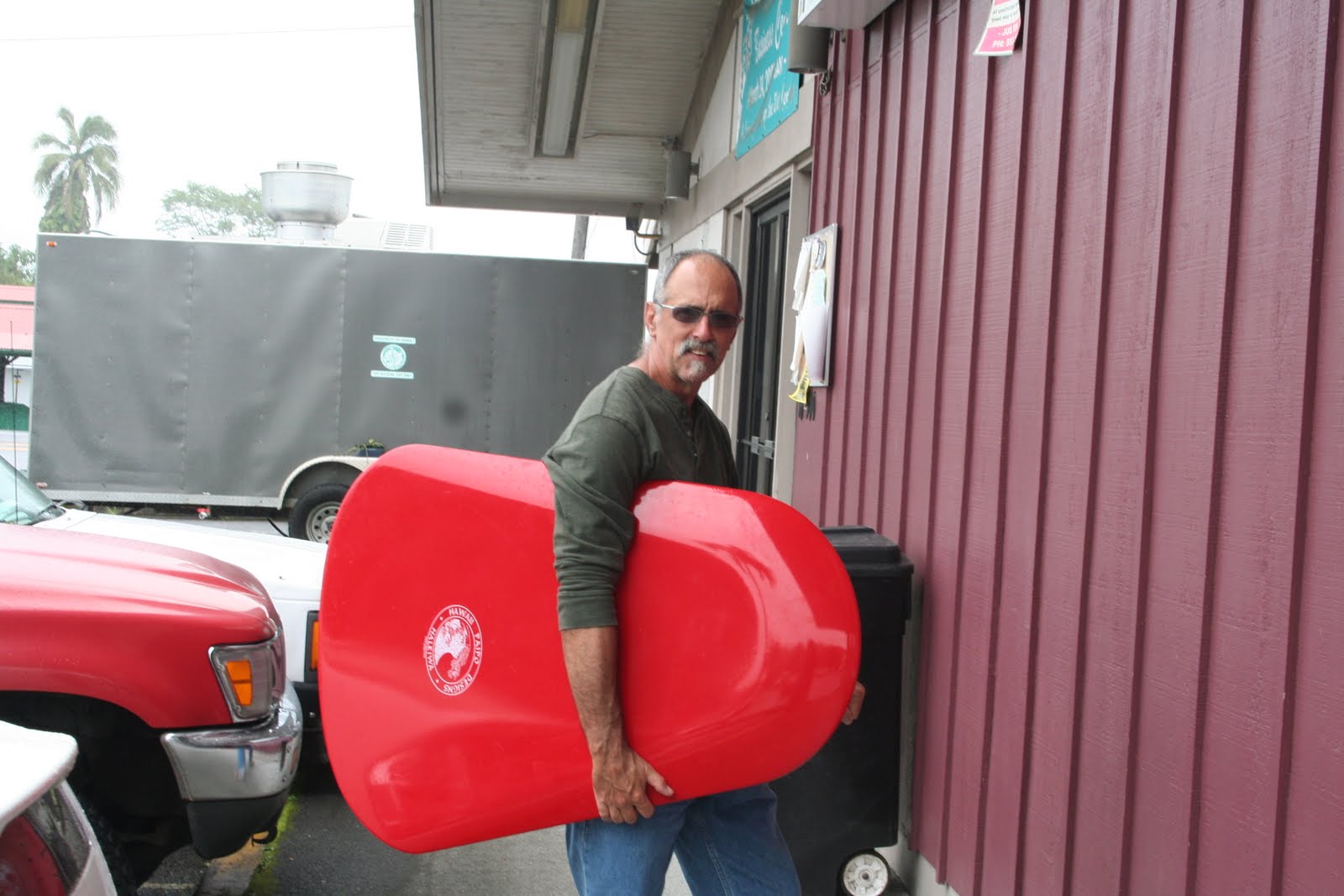
|
|
Paul holding the Flex Model, foam deck surface
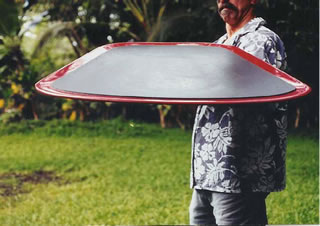
|
|
The Flex HPD, flexed
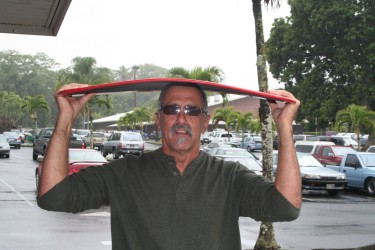
|
|
The Flex HPD, unflexed
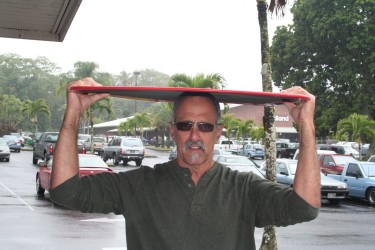
|
|
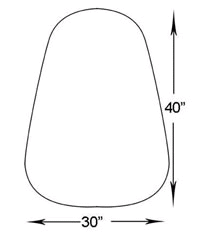
|
Photo credits: Top right foam deck and bottom dimensions figures are courtesy of Paul Lindbergh, Hawaii Paipo Designs. Other figures are courtesy of Ted Hon.
|
|
|
|
Ted Hon riding his Paipo XL Plus at Salani, Samoa (Jan. 2008)
|
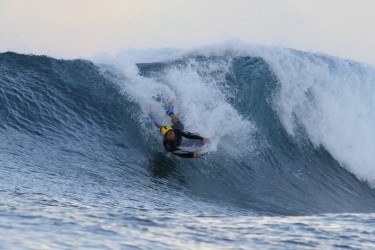
|
|
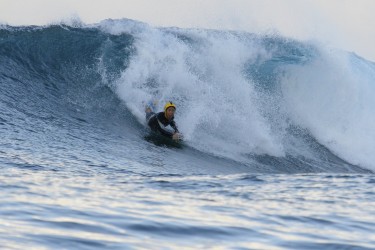
|
|
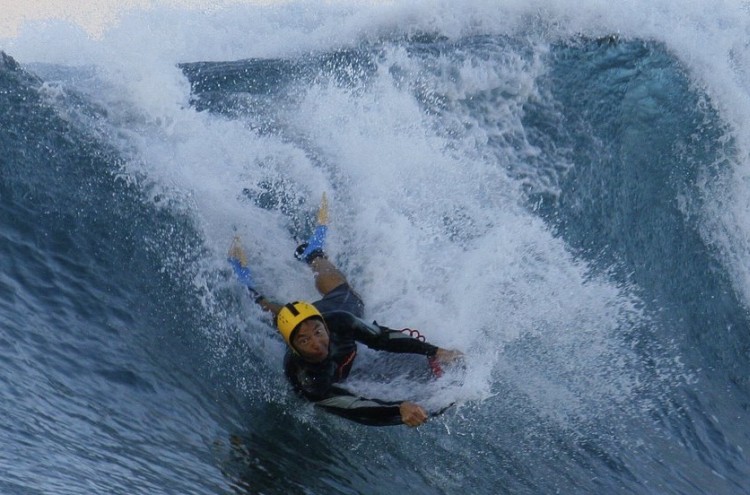
Photographs courtesy of Ted Hon. |
|
Also see Paul's website, Hawaii Paipo Designs: The Fastest Body Boards on the Planet by Paul Lindbergh.
|
|